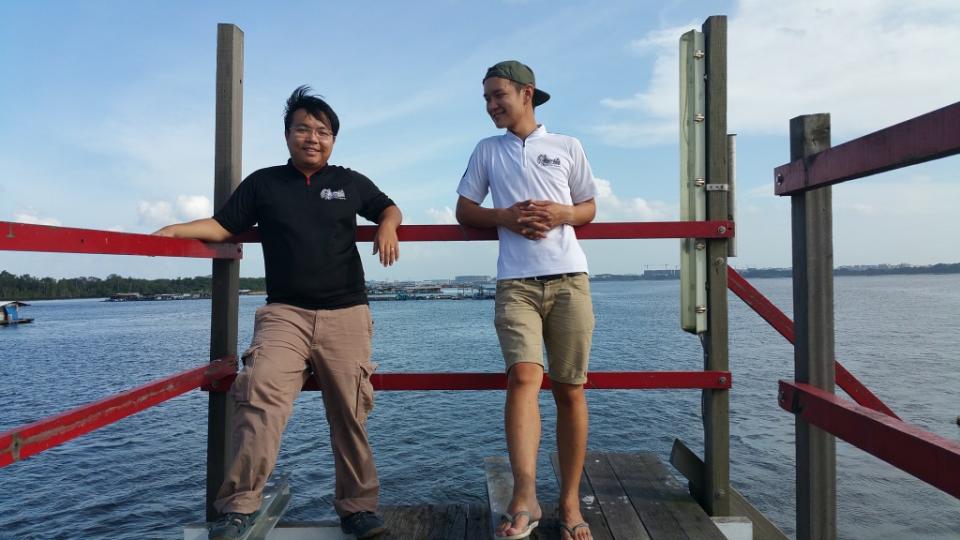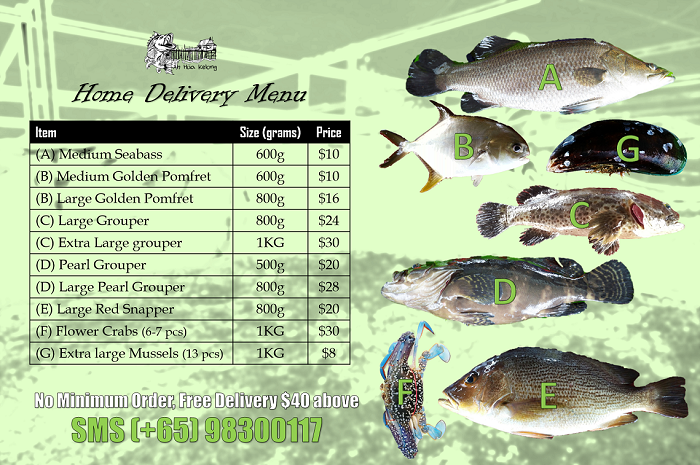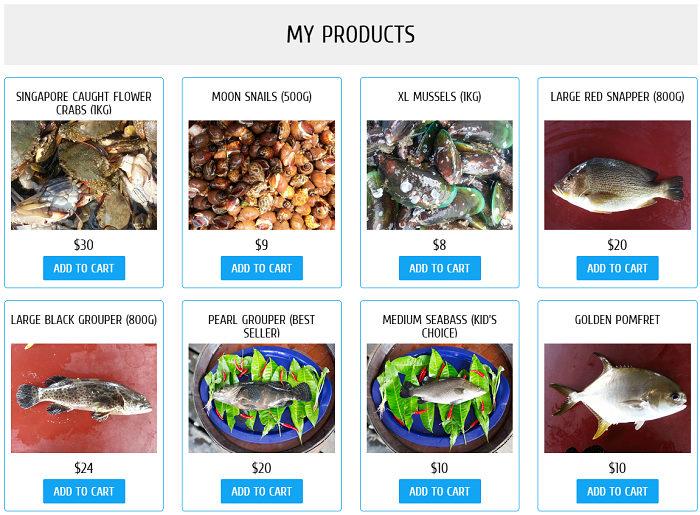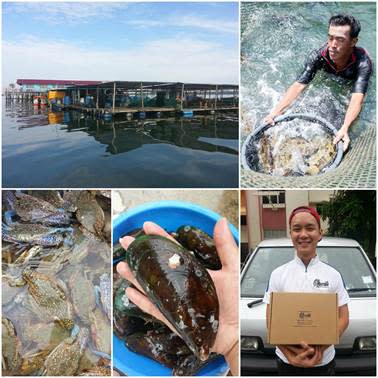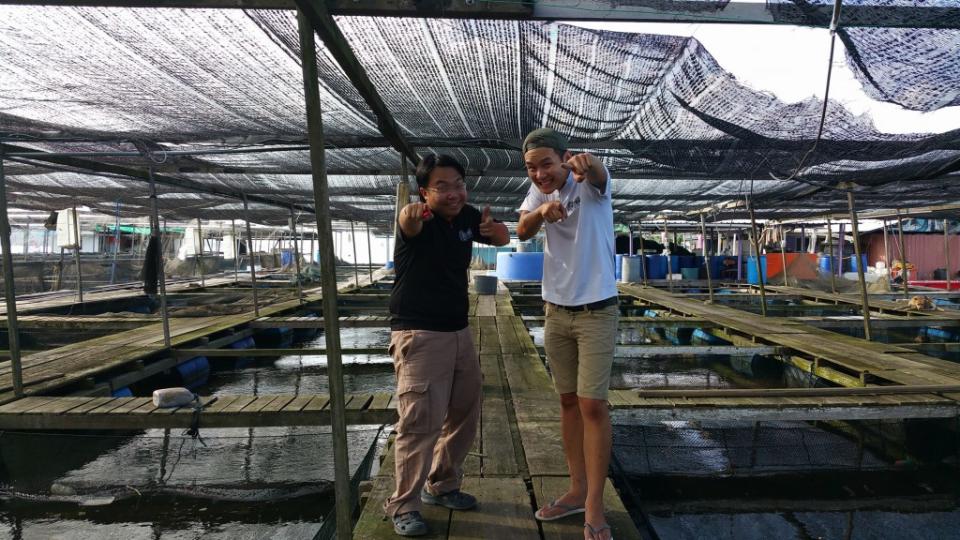Ah Hua Kelong: 25-Year-Old Young Upstarts Revolutionize Fish Farming

This Article Originally Appeared On Vulcan Post.
Jing Kai and Bryan might just be 25 years old, but they have certainly chosen the route less taken. After all, how many young people can be found working on a fish kelong, of all places?
The two friends first met during BMT (Basic Military Training) in the army six years ago, and they have been tight as thieves since. These days, Jing Kai (or Kai, as he is known) helms business development for Ah Hua Kelong, while Bryan takes on the role of Creative and Marketing Director.
The crew at Ah Hua Kelong. (Image Credit: Ah Hua Kelong)
Ah Hua Kelong specializes in delivering a variety of fresh, local seafood (golden pomfret, seabass, grouper, green mussels and flower crabs) from their fish farm to the consumer, available to order on their website and Qoo10. Life on the farm is a pretty hands-on affair for the two, with them pitching in for the preparation of pre-made sauces and ingredients (a premium service they provide for customers), as well as the delivery of the fishes. Their website also provides recipe instructions for customers.
Take a look at Ah Hua Kelong’s Facebook page and you can get a glimpse of the friendly, down-to-earth service the pair strives to provide to customers. Updates on delivery areas and timings are provided constantly, as well as insights into the ongoing activities of the working crew. Their crabber Ah Tan, for instance, sustained deep cuts on his hands while harvesting mussels.
Image Credit: Ah Hua Kelong’s Facebook page
Vulcan Post speaks to the duo about working hard on the kelong, where a typical day starts at 1am and ends around 10pm.
From left to right: Bryan and Kai. (Image Credit: Ah Hua Kelong)
1) Hello Kai and Bryan! Can you tell us about how you came to be part of Ah Hua Kelong?
Bryan: I was working with Mr Teh, the owner of the fish farm, for many years supplying him with many customers to his farm on a frequent basis.
Kai: For me, it all began one faithful day while both of us happened to be tasked to guard the ammo point for a few hours during our reservist last year. That was when creative juices started to flow and when Bryan shared this idea then, I didn’t know it would be a life-changer. It certainly changed what I thought my career path would have been if we hadn’t had that chat or started this venture.
Image Credit: Ah Hua Kelong
2) Tell us about what you are trying to achieve with Ah Hua Kelong.
The name ‘Ah Hua Kelong’ is a branding effort with two purposes.
Firstly, we wanted to differentiate our seafood from other seafood providers. Farming ethically is never cheap, thus with a brand name, we are able to let our customers know that we price our seafood as such because of the ethical techniques we use for farming. When they do online shopping and see our brand, they know that they are paying for fresh quality seafood, so that their family can enjoy a tasty meal with peace of mind.
Secondly, Ah Hua Kelong is set up to penetrate the home delivery market. In the past, we relied solely on Hong Kong buyers and intermediaries who buy our fishes in large quantities. However, price competition and a plankton bloom early this year which killed almost all our live stock, have diminished the long-term viability of this avenue. We realised we needed more distribution channels, so voilà, here we are!
Image Credit: Ah Hua Kelong
Another contributing factor was that we wanted to have a unique selling point which would help us stand out from overseas seafood importers. While these imports are slightly cheaper due to lower operating costs, we are able to deliver fresh, superior-grade seafood within a 12-hour window, as compared to the 1 day to a week window that these importers work on.
The bulk of local fish farms’ supplies is usually sold to restaurants but they have very specific requirements (each fish must weigh between 500g and 1.2kg) and won’t buy fish which are too big. With consumers, we have a little more flexibility and they are also more keen to share about our products with their friends, whereas restaurants would consider their suppliers a trade secret.
Image Credit: Ah Hua Kelong
3) Are the fishes, mussels and crabs, which Ah Hua Kelong delivers to homes, more expensive as compared to those sold in the wet markets and supermarkets?
The price of farmed fish is more stable while wet market fish prices fluctuate depending on the supply. We would say we are slightly more expensive, but still very affordable, and there are reasons why you’re paying a premium for fish from local farms.
We raise our fish on a diet of freshly caught ikan bilis, bait fish and high-quality feed, which give them superior colour, fattiness, firmer texture and sweeter taste.
We also need to factor in Singapore’s high labour and transportation costs but in exchange, customers get the freshest seafood delivered to their doorstep.
All in a day’s work. (Image Credit: Ah Hua Kelong)
4) How has the kelong’s home delivery business grown since it was first launched in April? On average, how many deliveries were done per month in May? On average, how many deliveries are done per month now?
The volume of home deliveries is steadily increasing and we expect it to take up a sizable percentage of total sales volume in the coming months.
When we started delivering home deliveries in May 2014, we had to fulfil about 240 orders monthly. Currently, that number has doubled to 450. But more importantly, we are very satisfied with the amount of feedback, compliments and press coverage we’ve received.
Also Read: Thomas Yang: Singaporean Artist Goes Viral With Tyre Art
Image Credit: Ah Hua Kelong
5) What industries were both of you working in prior to Ah Hua Kelong?
Bryan: I’m a degree/master level private tutor in Business. I’m also the owner of a company for commercial and recreational boat charters. Ever since Ah Hua Kelong, I’ve stopped tutoring and am focusing more on my businesses.
Kai: I used to be in the digital marketing field working for a local google partner which I left once we started to get things moving with the current business.
6) What motivated you in the change of career?
Changing your career is never easy. But as a younger generation Singaporean, we naturally have an instinct to want to have something we can call our own. What’s more, this business opportunity sounded very good when we discussed it during reservist. We are able to work well with each other, so we became partners.
7) What have you implemented since you joined which has worked for Ah Hua Kelong?
There are many strategies which we implemented.
The most important implementation was actually the company’s values and principles. We vow to provide fresh quality seafood. We vow to provide high quality customer service. We vow to practise ethical farming. These values set the tone as to what we do and how we farm and sell the seafood.
Image Credit: Ah Hua Kelong
8) We can see that both of you have a lot of fun on the farm. Can you describe a typical day at work?
1.00am: Bryan will prepare sauces and fresh ingredients for pre-made ingredient and set them aside for delivery.
5.00am: Our feeder, Ah Yong, will haul up nets to catch bait fish (used to feed our fishes) and store them in the freezer.
6.00am: Ah Yong will start to harvest the fishes for the day’s order.
9.00am: Kai reaches jetty to collect the fishes from Ah Yong to deliver to the slaughter house.
10.30am: Our delivery crew, Edward, meets with Kai to collect the seafood and checks route for delivery.
1.00pm: Our Crabber, Ah Tan, returns to the farm with his bounty of flower crabs and stores them in the nets.
2.00pm: Our feeders, Ah Ming and Ah Yong, get busy. Ah Ming feeds the fishes, while Ah Yong changes the sea cages and then washes them.
4.00pm: Ah Yong will start diving to harvest extra large mussels.
10.00pm: Last order is taken for the day. Bryan starts consolidating all orders and plans the route. The seafood items are then consolidated.
Image Credit: Ah Hua Kelong
9) Do you live on the farm full-time? Were there any things you had to try to get used to?
Bryan: Kai and I don’t stay on the farm full-time, but we have to be there on many occasions to oversee the operations, coordinate the meetings and media visits.
Mosquitoes are a real pain over at our farm, or any other farm for that matter. Our farm is near Pulau Ubin and since we do own many barrels to store rain water, we started to farm mosquitoes by accident. We have since covered these barrels with custom covers, and they have worked pretty well.
10) Are there any interesting or funny stories while working on the farm?
Bryan: There are quite a few! We rely heavily on our big net to catch small fishes to feed to our farm fishes. Occasionally, we will net up big fishes such as barracuda and cuttle fish. These are normally kept in the bait fridge and I’ll use them to prepare for my lunch the next day. Almost without fail, Ah Ming will take off with my lunch ingredients, salt and then hang them on the wall to sun.
And then there was that one time – it rained all of a sudden and Ah Ming actually ran out midway during his shower to save his salted fish! We all burst into laughter!
Also Read: Bowen Beckman: The Six-Year-old Boy Changing The World
The post Ah Hua Kelong: 25-Year-Old Young Upstarts Revolutionize Fish Farming appeared first on Vulcan Post.




